Nursing Portfolio: Leadership and Infection Control Measures in ED
VerifiedAdded on 2023/06/12
|21
|4521
|367
Portfolio
AI Summary
This nursing portfolio demonstrates the student's increasing knowledge of effective leadership and infection control measures within an emergency department setting. The portfolio includes activities such as developing concept maps illustrating leadership attributes, giving presentations on leadership styles and healthcare personnel vaccinations, attending online courses on aseptic techniques, and reviewing literature on personal protective equipment. Reflections on these activities reveal insights into the importance of leadership in clinical settings, the application of different leadership traits, and the rationale for using personal protective equipment to reduce the risk of secondary infections. The student also reflects on the challenges and benefits of online learning and the importance of communication skills in nursing practice. The portfolio fulfills specific learning objectives related to enhancing communication skills, synthesizing knowledge, and appraising research evidence to improve nursing practice for optimal patient outcomes.
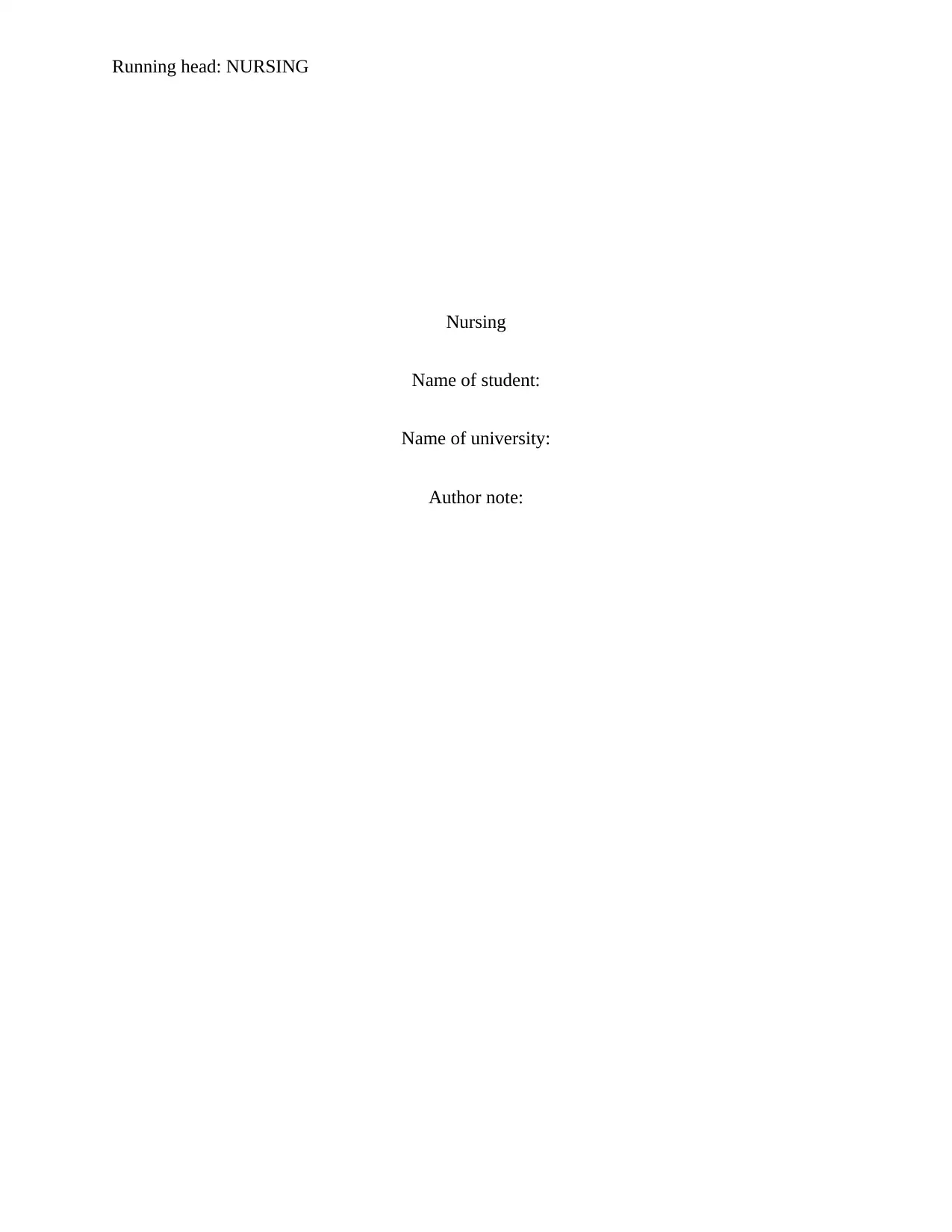
Running head: NURSING
Nursing
Name of student:
Name of university:
Author note:
Nursing
Name of student:
Name of university:
Author note:
Paraphrase This Document
Need a fresh take? Get an instant paraphrase of this document with our AI Paraphraser
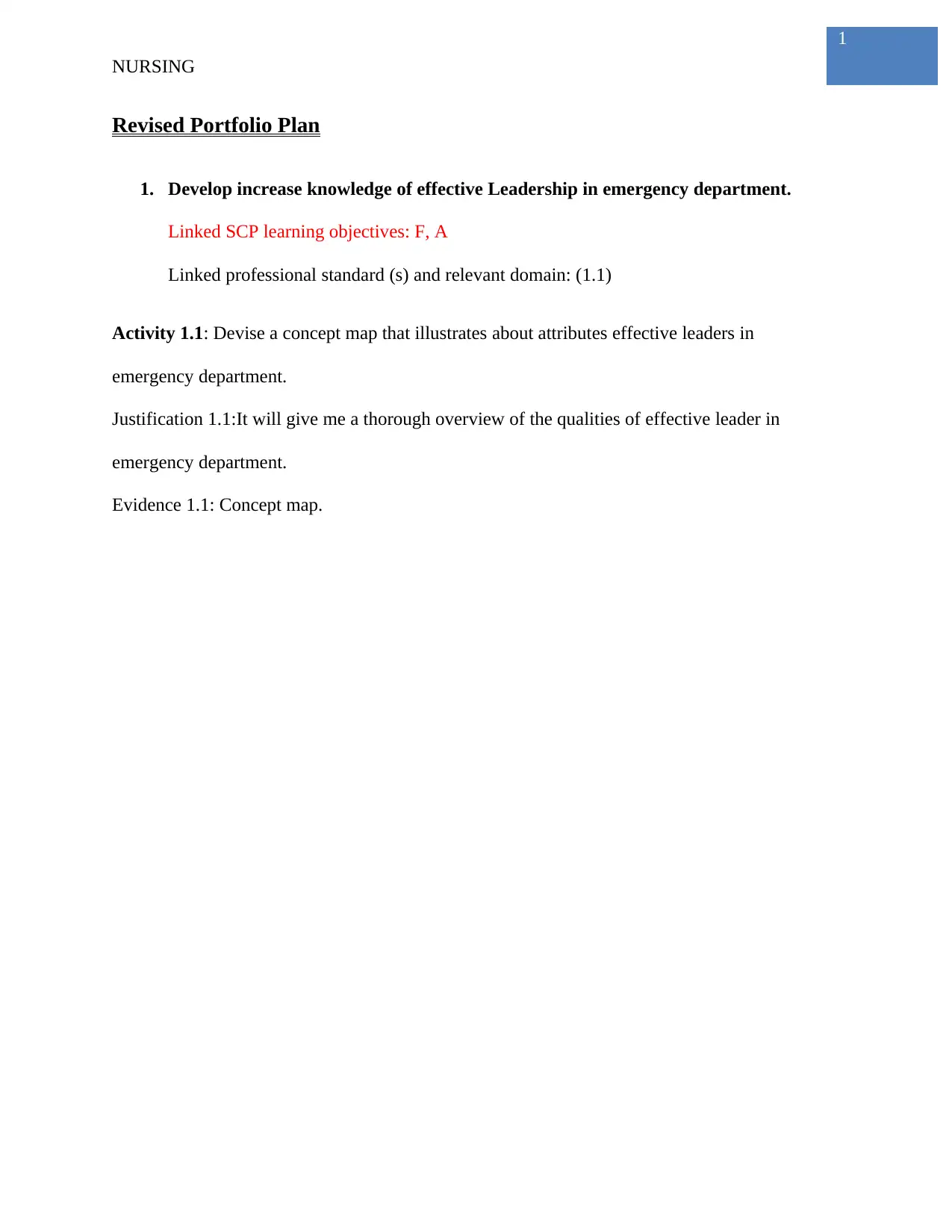
1
NURSING
Revised Portfolio Plan
1. Develop increase knowledge of effective Leadership in emergency department.
Linked SCP learning objectives: F, A
Linked professional standard (s) and relevant domain: (1.1)
Activity 1.1: Devise a concept map that illustrates about attributes effective leaders in
emergency department.
Justification 1.1:It will give me a thorough overview of the qualities of effective leader in
emergency department.
Evidence 1.1: Concept map.
NURSING
Revised Portfolio Plan
1. Develop increase knowledge of effective Leadership in emergency department.
Linked SCP learning objectives: F, A
Linked professional standard (s) and relevant domain: (1.1)
Activity 1.1: Devise a concept map that illustrates about attributes effective leaders in
emergency department.
Justification 1.1:It will give me a thorough overview of the qualities of effective leader in
emergency department.
Evidence 1.1: Concept map.

2
NURSING
Reflection- I was interested in designing the concept map about attributes effective
leaders in emergency department. I carried out research with the available resources as the
context of the study. I then devised the concept map as per my understanding. The activity gave
me the opportunity to learn about the importance of leadership in clinical settings and the
NURSING
Reflection- I was interested in designing the concept map about attributes effective
leaders in emergency department. I carried out research with the available resources as the
context of the study. I then devised the concept map as per my understanding. The activity gave
me the opportunity to learn about the importance of leadership in clinical settings and the
⊘ This is a preview!⊘
Do you want full access?
Subscribe today to unlock all pages.

Trusted by 1+ million students worldwide
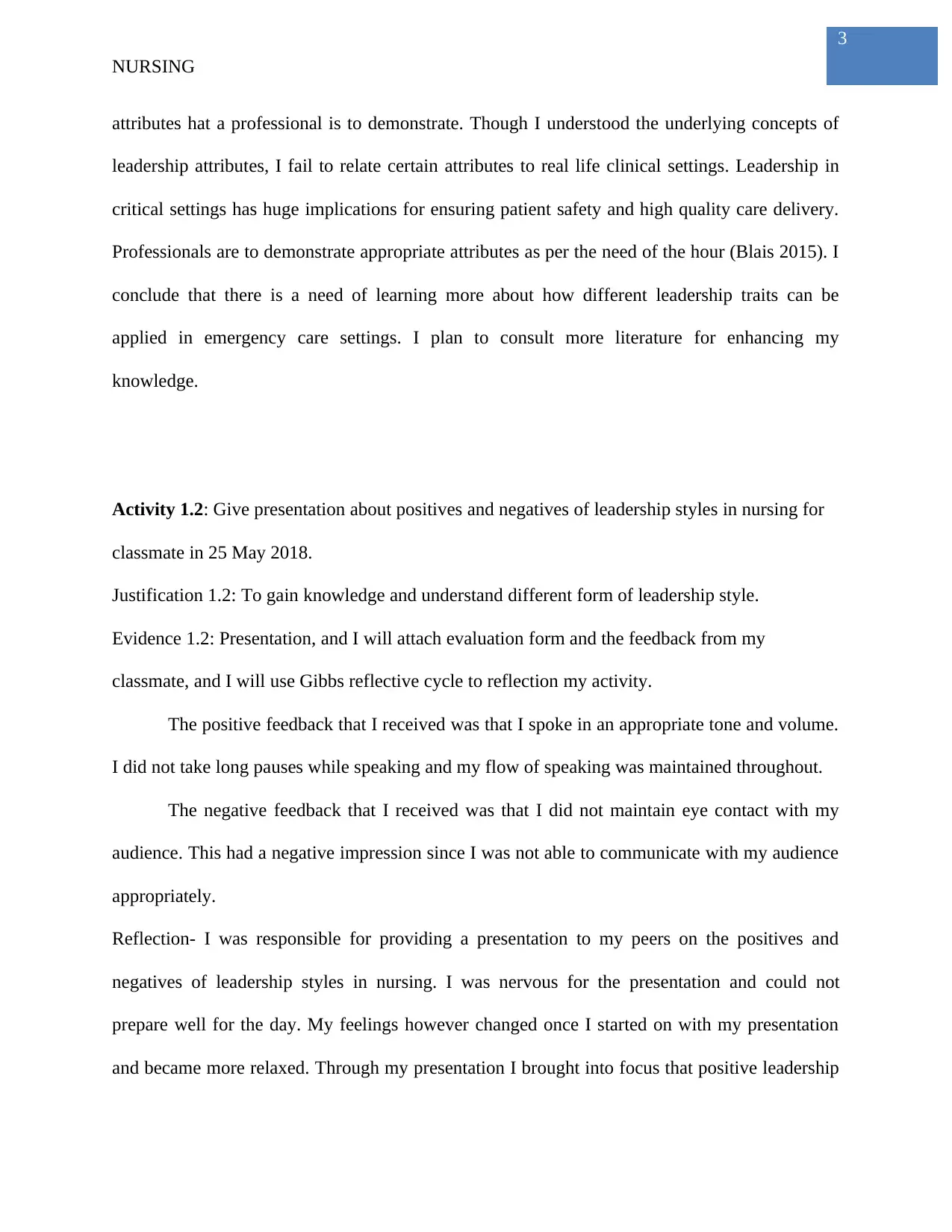
3
NURSING
attributes hat a professional is to demonstrate. Though I understood the underlying concepts of
leadership attributes, I fail to relate certain attributes to real life clinical settings. Leadership in
critical settings has huge implications for ensuring patient safety and high quality care delivery.
Professionals are to demonstrate appropriate attributes as per the need of the hour (Blais 2015). I
conclude that there is a need of learning more about how different leadership traits can be
applied in emergency care settings. I plan to consult more literature for enhancing my
knowledge.
Activity 1.2: Give presentation about positives and negatives of leadership styles in nursing for
classmate in 25 May 2018.
Justification 1.2: To gain knowledge and understand different form of leadership style.
Evidence 1.2: Presentation, and I will attach evaluation form and the feedback from my
classmate, and I will use Gibbs reflective cycle to reflection my activity.
The positive feedback that I received was that I spoke in an appropriate tone and volume.
I did not take long pauses while speaking and my flow of speaking was maintained throughout.
The negative feedback that I received was that I did not maintain eye contact with my
audience. This had a negative impression since I was not able to communicate with my audience
appropriately.
Reflection- I was responsible for providing a presentation to my peers on the positives and
negatives of leadership styles in nursing. I was nervous for the presentation and could not
prepare well for the day. My feelings however changed once I started on with my presentation
and became more relaxed. Through my presentation I brought into focus that positive leadership
NURSING
attributes hat a professional is to demonstrate. Though I understood the underlying concepts of
leadership attributes, I fail to relate certain attributes to real life clinical settings. Leadership in
critical settings has huge implications for ensuring patient safety and high quality care delivery.
Professionals are to demonstrate appropriate attributes as per the need of the hour (Blais 2015). I
conclude that there is a need of learning more about how different leadership traits can be
applied in emergency care settings. I plan to consult more literature for enhancing my
knowledge.
Activity 1.2: Give presentation about positives and negatives of leadership styles in nursing for
classmate in 25 May 2018.
Justification 1.2: To gain knowledge and understand different form of leadership style.
Evidence 1.2: Presentation, and I will attach evaluation form and the feedback from my
classmate, and I will use Gibbs reflective cycle to reflection my activity.
The positive feedback that I received was that I spoke in an appropriate tone and volume.
I did not take long pauses while speaking and my flow of speaking was maintained throughout.
The negative feedback that I received was that I did not maintain eye contact with my
audience. This had a negative impression since I was not able to communicate with my audience
appropriately.
Reflection- I was responsible for providing a presentation to my peers on the positives and
negatives of leadership styles in nursing. I was nervous for the presentation and could not
prepare well for the day. My feelings however changed once I started on with my presentation
and became more relaxed. Through my presentation I brought into focus that positive leadership
Paraphrase This Document
Need a fresh take? Get an instant paraphrase of this document with our AI Paraphraser
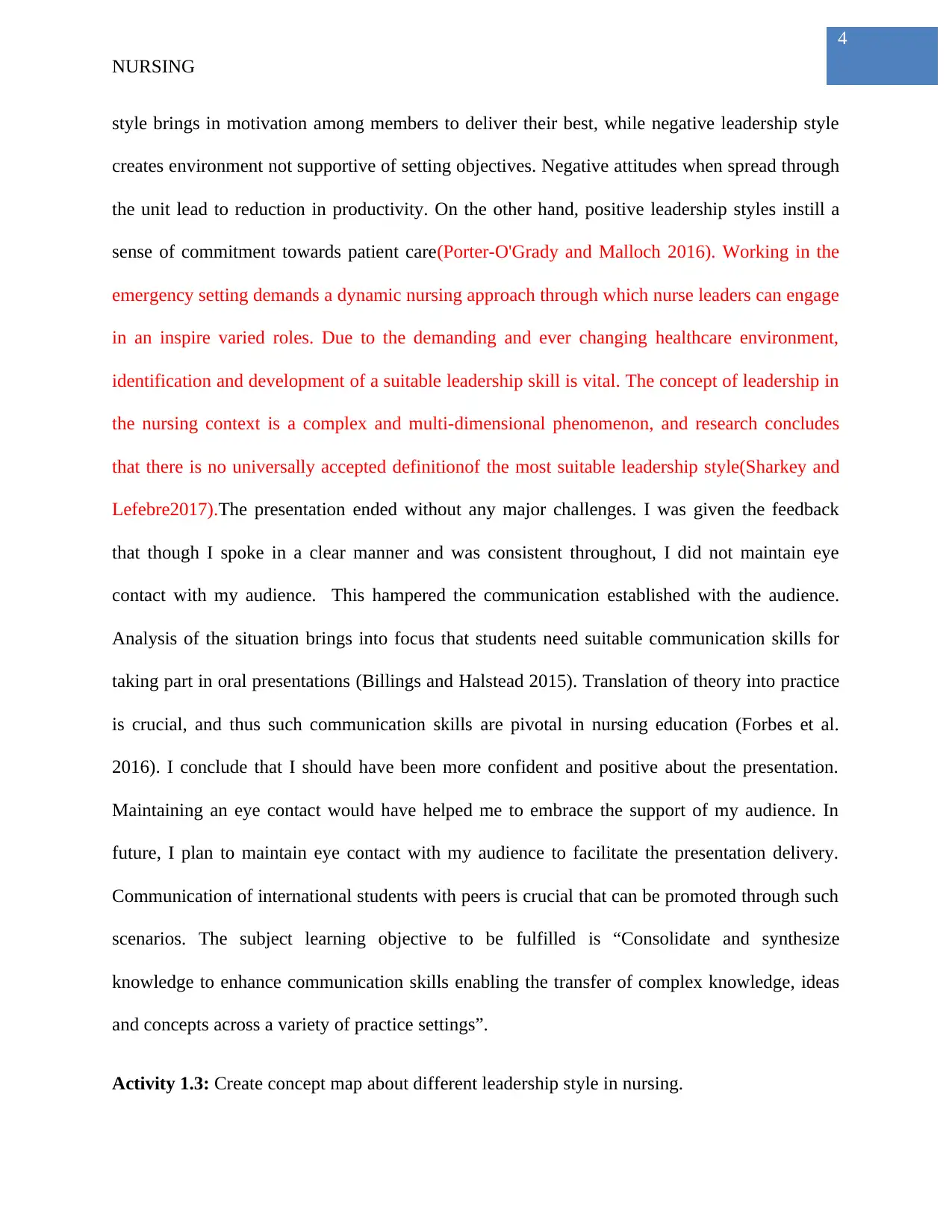
4
NURSING
style brings in motivation among members to deliver their best, while negative leadership style
creates environment not supportive of setting objectives. Negative attitudes when spread through
the unit lead to reduction in productivity. On the other hand, positive leadership styles instill a
sense of commitment towards patient care(Porter-O'Grady and Malloch 2016). Working in the
emergency setting demands a dynamic nursing approach through which nurse leaders can engage
in an inspire varied roles. Due to the demanding and ever changing healthcare environment,
identification and development of a suitable leadership skill is vital. The concept of leadership in
the nursing context is a complex and multi-dimensional phenomenon, and research concludes
that there is no universally accepted definitionof the most suitable leadership style(Sharkey and
Lefebre2017).The presentation ended without any major challenges. I was given the feedback
that though I spoke in a clear manner and was consistent throughout, I did not maintain eye
contact with my audience. This hampered the communication established with the audience.
Analysis of the situation brings into focus that students need suitable communication skills for
taking part in oral presentations (Billings and Halstead 2015). Translation of theory into practice
is crucial, and thus such communication skills are pivotal in nursing education (Forbes et al.
2016). I conclude that I should have been more confident and positive about the presentation.
Maintaining an eye contact would have helped me to embrace the support of my audience. In
future, I plan to maintain eye contact with my audience to facilitate the presentation delivery.
Communication of international students with peers is crucial that can be promoted through such
scenarios. The subject learning objective to be fulfilled is “Consolidate and synthesize
knowledge to enhance communication skills enabling the transfer of complex knowledge, ideas
and concepts across a variety of practice settings”.
Activity 1.3: Create concept map about different leadership style in nursing.
NURSING
style brings in motivation among members to deliver their best, while negative leadership style
creates environment not supportive of setting objectives. Negative attitudes when spread through
the unit lead to reduction in productivity. On the other hand, positive leadership styles instill a
sense of commitment towards patient care(Porter-O'Grady and Malloch 2016). Working in the
emergency setting demands a dynamic nursing approach through which nurse leaders can engage
in an inspire varied roles. Due to the demanding and ever changing healthcare environment,
identification and development of a suitable leadership skill is vital. The concept of leadership in
the nursing context is a complex and multi-dimensional phenomenon, and research concludes
that there is no universally accepted definitionof the most suitable leadership style(Sharkey and
Lefebre2017).The presentation ended without any major challenges. I was given the feedback
that though I spoke in a clear manner and was consistent throughout, I did not maintain eye
contact with my audience. This hampered the communication established with the audience.
Analysis of the situation brings into focus that students need suitable communication skills for
taking part in oral presentations (Billings and Halstead 2015). Translation of theory into practice
is crucial, and thus such communication skills are pivotal in nursing education (Forbes et al.
2016). I conclude that I should have been more confident and positive about the presentation.
Maintaining an eye contact would have helped me to embrace the support of my audience. In
future, I plan to maintain eye contact with my audience to facilitate the presentation delivery.
Communication of international students with peers is crucial that can be promoted through such
scenarios. The subject learning objective to be fulfilled is “Consolidate and synthesize
knowledge to enhance communication skills enabling the transfer of complex knowledge, ideas
and concepts across a variety of practice settings”.
Activity 1.3: Create concept map about different leadership style in nursing.
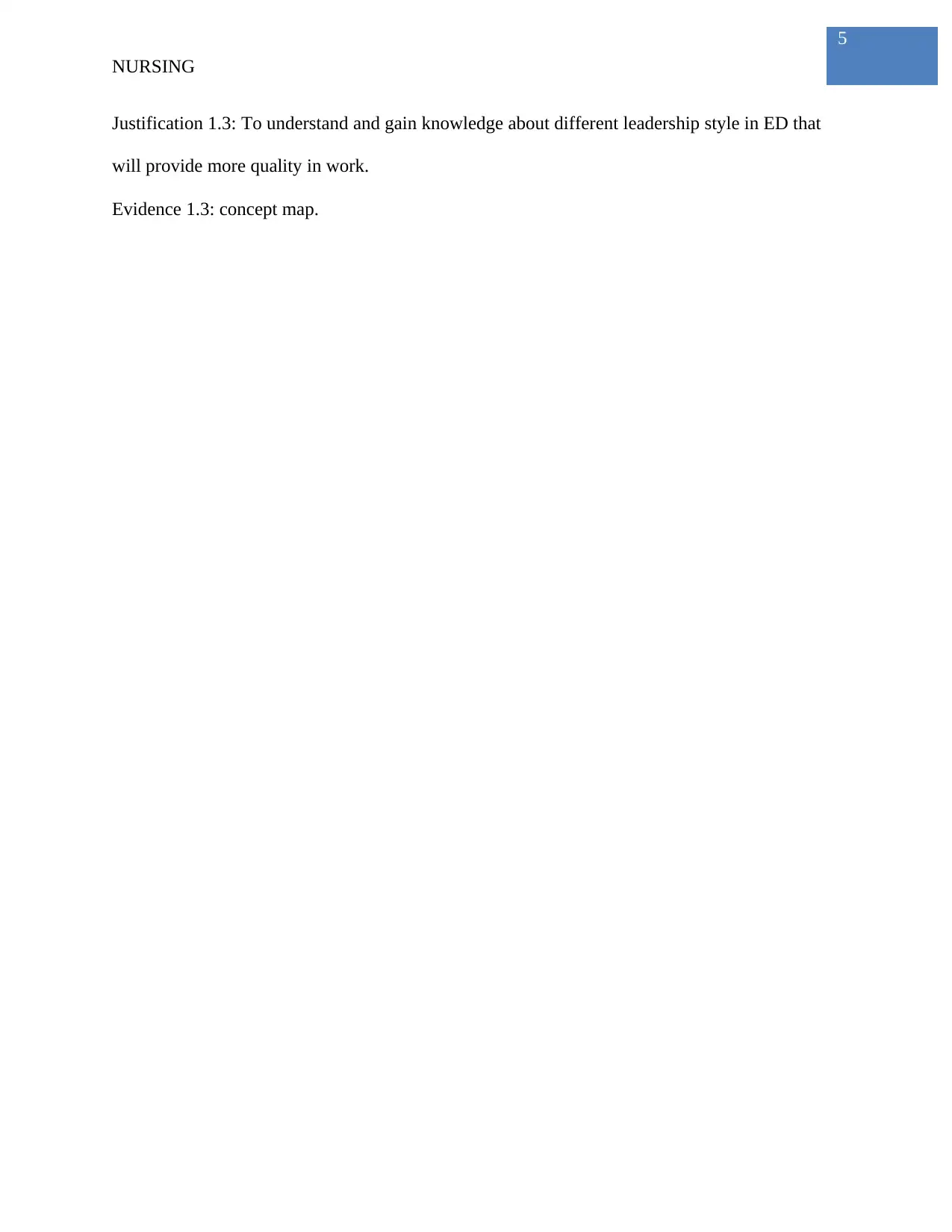
5
NURSING
Justification 1.3: To understand and gain knowledge about different leadership style in ED that
will provide more quality in work.
Evidence 1.3: concept map.
NURSING
Justification 1.3: To understand and gain knowledge about different leadership style in ED that
will provide more quality in work.
Evidence 1.3: concept map.
⊘ This is a preview!⊘
Do you want full access?
Subscribe today to unlock all pages.

Trusted by 1+ million students worldwide
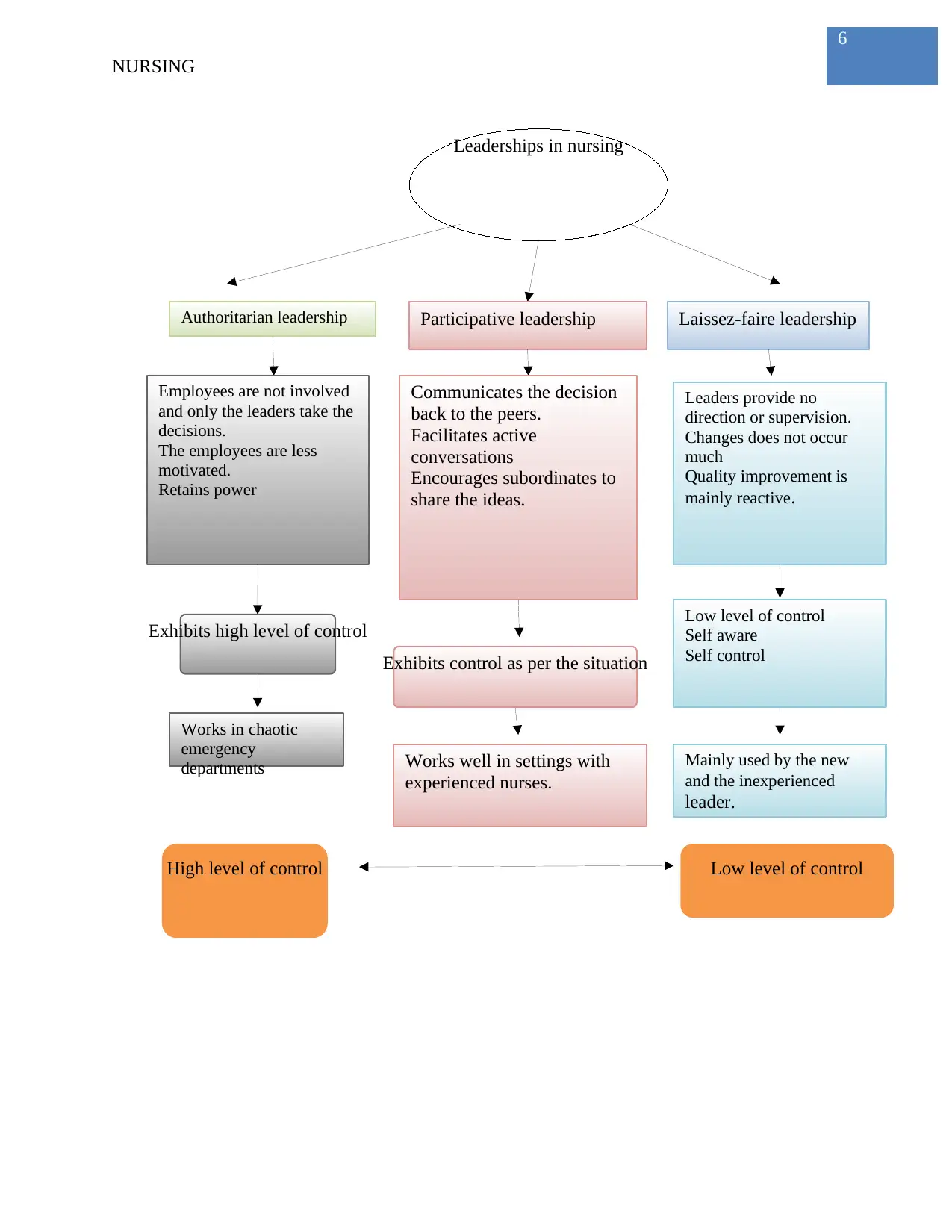
6
Leaderships in nursing
Authoritarian leadership
Employees are not involved
and only the leaders take the
decisions.
The employees are less
motivated.
Retains power
Exhibits high level of control
Works in chaotic
emergency
departments
Participative leadership
Communicates the decision
back to the peers.
Facilitates active
conversations
Encourages subordinates to
share the ideas.
Laissez-faire leadership
Leaders provide no
direction or supervision.
Changes does not occur
much
Quality improvement is
mainly reactive.
Low level of control
Self aware
Self control
Mainly used by the new
and the inexperienced
leader.
Exhibits control as per the situation
Works well in settings with
experienced nurses.
High level of control Low level of control
NURSING
Leaderships in nursing
Authoritarian leadership
Employees are not involved
and only the leaders take the
decisions.
The employees are less
motivated.
Retains power
Exhibits high level of control
Works in chaotic
emergency
departments
Participative leadership
Communicates the decision
back to the peers.
Facilitates active
conversations
Encourages subordinates to
share the ideas.
Laissez-faire leadership
Leaders provide no
direction or supervision.
Changes does not occur
much
Quality improvement is
mainly reactive.
Low level of control
Self aware
Self control
Mainly used by the new
and the inexperienced
leader.
Exhibits control as per the situation
Works well in settings with
experienced nurses.
High level of control Low level of control
NURSING
Paraphrase This Document
Need a fresh take? Get an instant paraphrase of this document with our AI Paraphraser
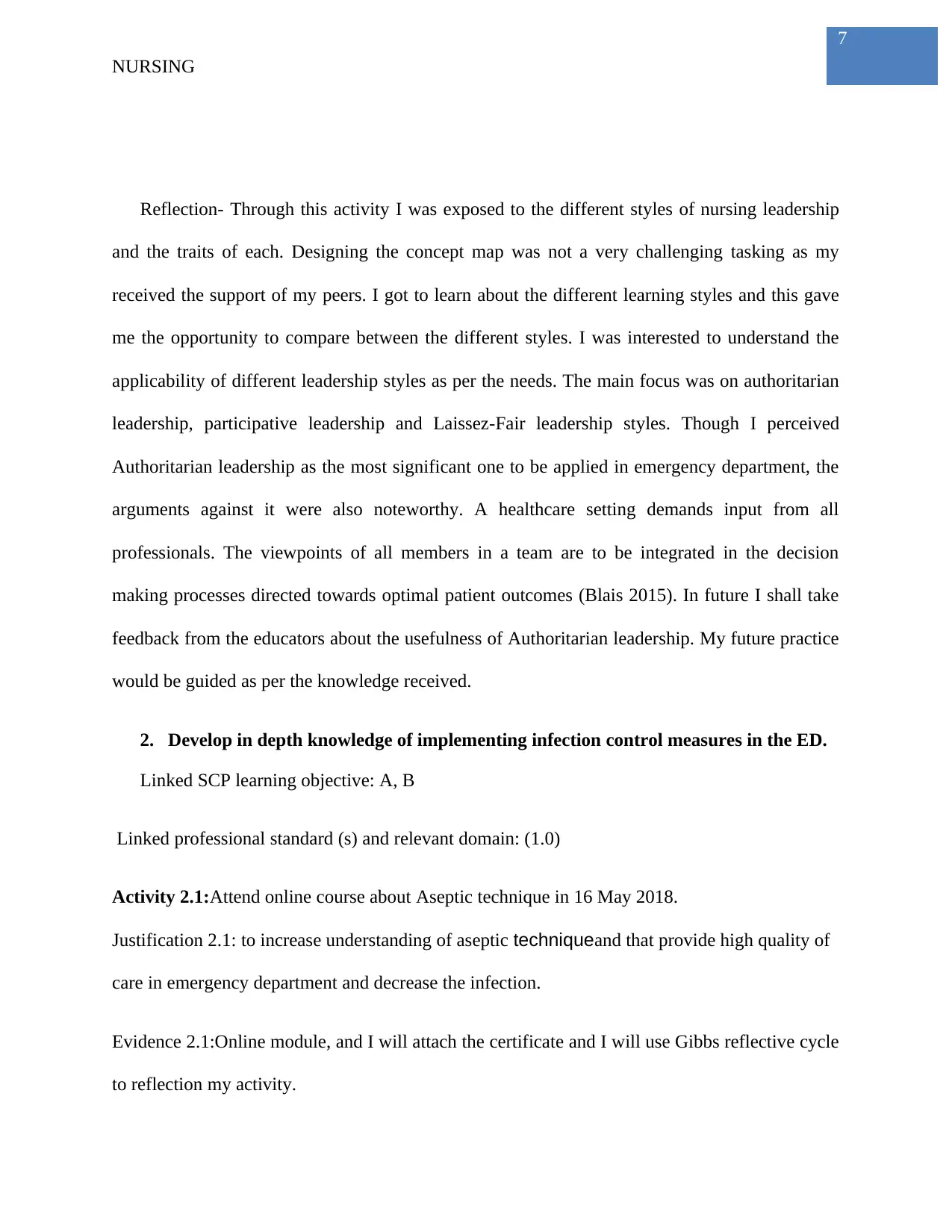
7
NURSING
Reflection- Through this activity I was exposed to the different styles of nursing leadership
and the traits of each. Designing the concept map was not a very challenging tasking as my
received the support of my peers. I got to learn about the different learning styles and this gave
me the opportunity to compare between the different styles. I was interested to understand the
applicability of different leadership styles as per the needs. The main focus was on authoritarian
leadership, participative leadership and Laissez-Fair leadership styles. Though I perceived
Authoritarian leadership as the most significant one to be applied in emergency department, the
arguments against it were also noteworthy. A healthcare setting demands input from all
professionals. The viewpoints of all members in a team are to be integrated in the decision
making processes directed towards optimal patient outcomes (Blais 2015). In future I shall take
feedback from the educators about the usefulness of Authoritarian leadership. My future practice
would be guided as per the knowledge received.
2. Develop in depth knowledge of implementing infection control measures in the ED.
Linked SCP learning objective: A, B
Linked professional standard (s) and relevant domain: (1.0)
Activity 2.1:Attend online course about Aseptic technique in 16 May 2018.
Justification 2.1: to increase understanding of aseptic techniqueand that provide high quality of
care in emergency department and decrease the infection.
Evidence 2.1:Online module, and I will attach the certificate and I will use Gibbs reflective cycle
to reflection my activity.
NURSING
Reflection- Through this activity I was exposed to the different styles of nursing leadership
and the traits of each. Designing the concept map was not a very challenging tasking as my
received the support of my peers. I got to learn about the different learning styles and this gave
me the opportunity to compare between the different styles. I was interested to understand the
applicability of different leadership styles as per the needs. The main focus was on authoritarian
leadership, participative leadership and Laissez-Fair leadership styles. Though I perceived
Authoritarian leadership as the most significant one to be applied in emergency department, the
arguments against it were also noteworthy. A healthcare setting demands input from all
professionals. The viewpoints of all members in a team are to be integrated in the decision
making processes directed towards optimal patient outcomes (Blais 2015). In future I shall take
feedback from the educators about the usefulness of Authoritarian leadership. My future practice
would be guided as per the knowledge received.
2. Develop in depth knowledge of implementing infection control measures in the ED.
Linked SCP learning objective: A, B
Linked professional standard (s) and relevant domain: (1.0)
Activity 2.1:Attend online course about Aseptic technique in 16 May 2018.
Justification 2.1: to increase understanding of aseptic techniqueand that provide high quality of
care in emergency department and decrease the infection.
Evidence 2.1:Online module, and I will attach the certificate and I will use Gibbs reflective cycle
to reflection my activity.
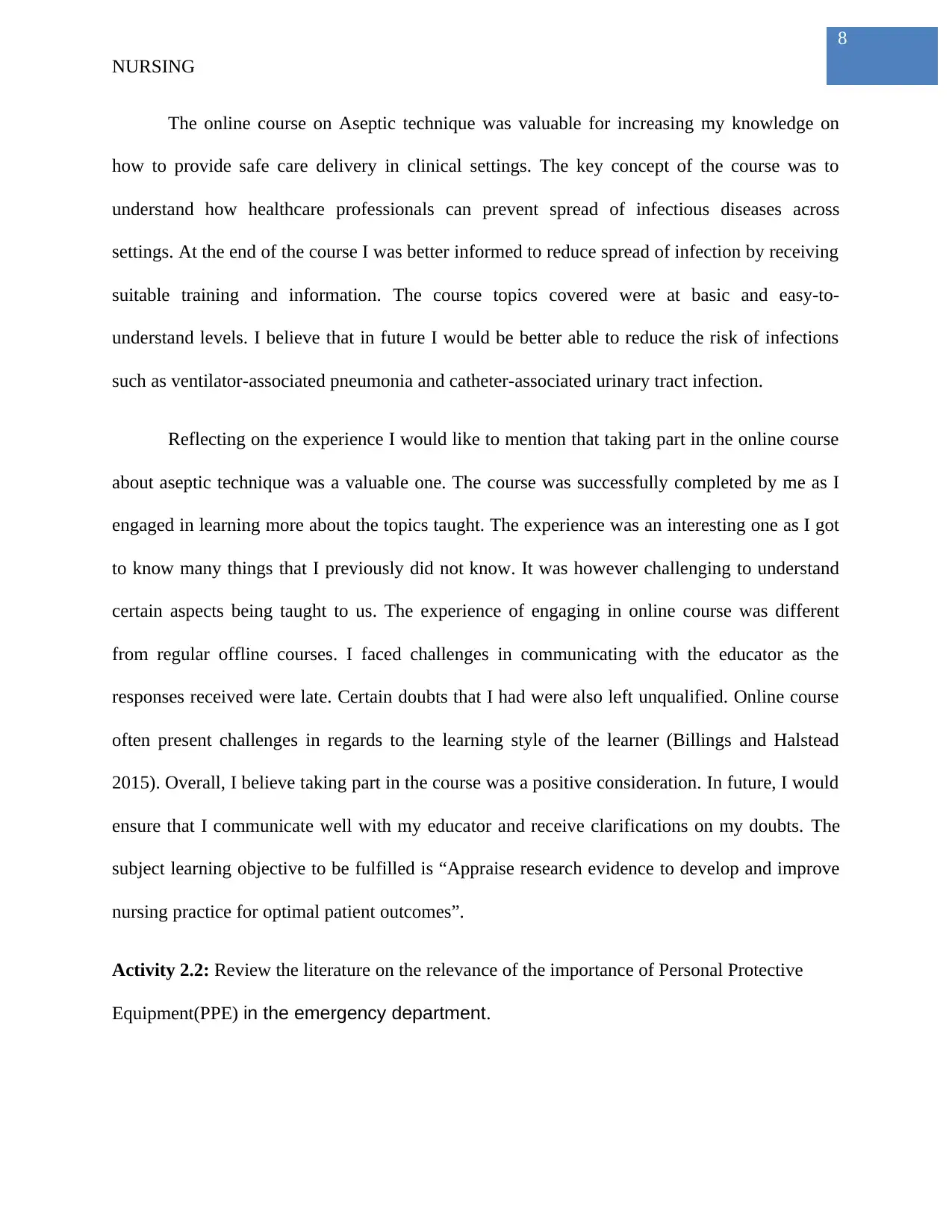
8
NURSING
The online course on Aseptic technique was valuable for increasing my knowledge on
how to provide safe care delivery in clinical settings. The key concept of the course was to
understand how healthcare professionals can prevent spread of infectious diseases across
settings. At the end of the course I was better informed to reduce spread of infection by receiving
suitable training and information. The course topics covered were at basic and easy-to-
understand levels. I believe that in future I would be better able to reduce the risk of infections
such as ventilator-associated pneumonia and catheter-associated urinary tract infection.
Reflecting on the experience I would like to mention that taking part in the online course
about aseptic technique was a valuable one. The course was successfully completed by me as I
engaged in learning more about the topics taught. The experience was an interesting one as I got
to know many things that I previously did not know. It was however challenging to understand
certain aspects being taught to us. The experience of engaging in online course was different
from regular offline courses. I faced challenges in communicating with the educator as the
responses received were late. Certain doubts that I had were also left unqualified. Online course
often present challenges in regards to the learning style of the learner (Billings and Halstead
2015). Overall, I believe taking part in the course was a positive consideration. In future, I would
ensure that I communicate well with my educator and receive clarifications on my doubts. The
subject learning objective to be fulfilled is “Appraise research evidence to develop and improve
nursing practice for optimal patient outcomes”.
Activity 2.2: Review the literature on the relevance of the importance of Personal Protective
Equipment(PPE) in the emergency department.
NURSING
The online course on Aseptic technique was valuable for increasing my knowledge on
how to provide safe care delivery in clinical settings. The key concept of the course was to
understand how healthcare professionals can prevent spread of infectious diseases across
settings. At the end of the course I was better informed to reduce spread of infection by receiving
suitable training and information. The course topics covered were at basic and easy-to-
understand levels. I believe that in future I would be better able to reduce the risk of infections
such as ventilator-associated pneumonia and catheter-associated urinary tract infection.
Reflecting on the experience I would like to mention that taking part in the online course
about aseptic technique was a valuable one. The course was successfully completed by me as I
engaged in learning more about the topics taught. The experience was an interesting one as I got
to know many things that I previously did not know. It was however challenging to understand
certain aspects being taught to us. The experience of engaging in online course was different
from regular offline courses. I faced challenges in communicating with the educator as the
responses received were late. Certain doubts that I had were also left unqualified. Online course
often present challenges in regards to the learning style of the learner (Billings and Halstead
2015). Overall, I believe taking part in the course was a positive consideration. In future, I would
ensure that I communicate well with my educator and receive clarifications on my doubts. The
subject learning objective to be fulfilled is “Appraise research evidence to develop and improve
nursing practice for optimal patient outcomes”.
Activity 2.2: Review the literature on the relevance of the importance of Personal Protective
Equipment(PPE) in the emergency department.
⊘ This is a preview!⊘
Do you want full access?
Subscribe today to unlock all pages.

Trusted by 1+ million students worldwide
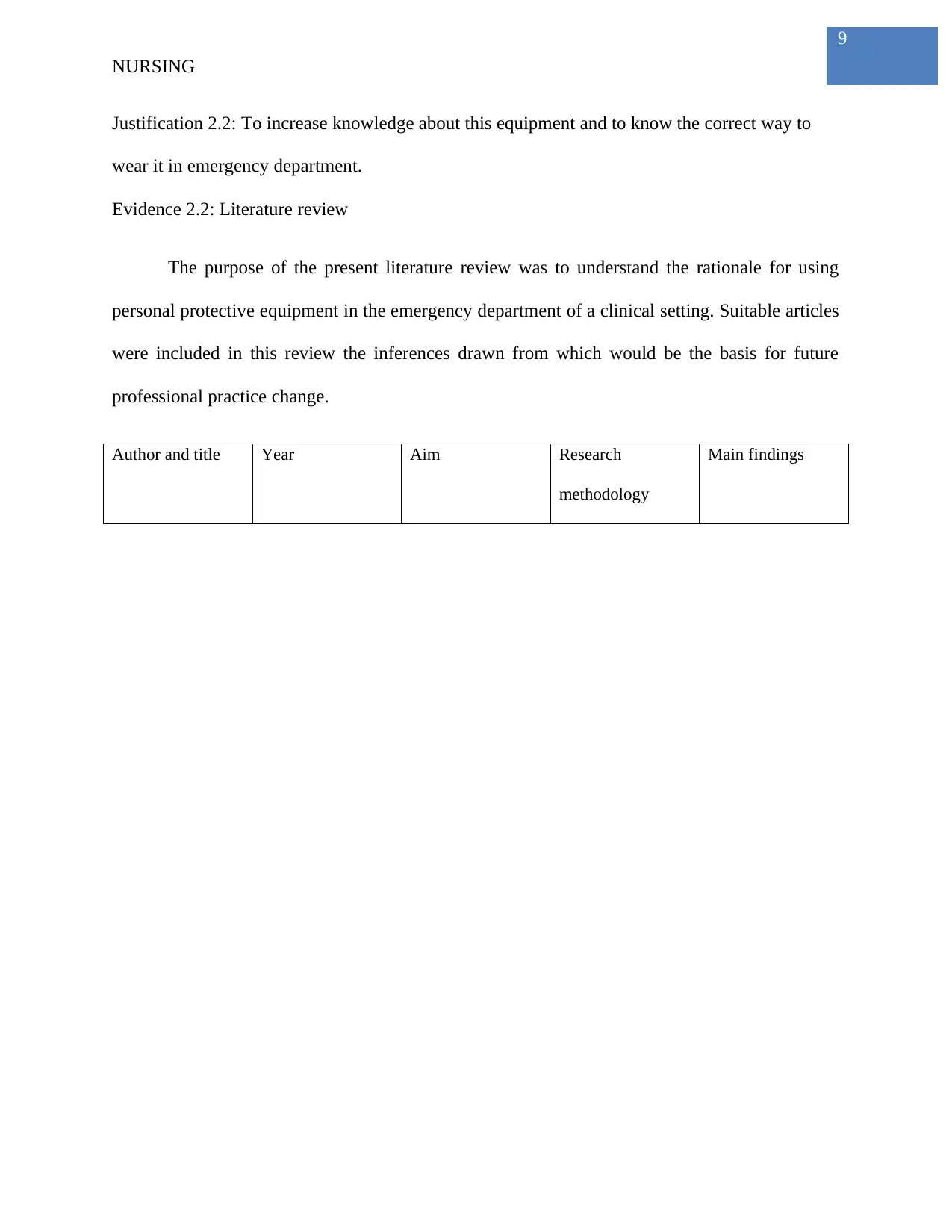
9
NURSING
Justification 2.2: To increase knowledge about this equipment and to know the correct way to
wear it in emergency department.
Evidence 2.2: Literature review
The purpose of the present literature review was to understand the rationale for using
personal protective equipment in the emergency department of a clinical setting. Suitable articles
were included in this review the inferences drawn from which would be the basis for future
professional practice change.
Author and title Year Aim Research
methodology
Main findings
NURSING
Justification 2.2: To increase knowledge about this equipment and to know the correct way to
wear it in emergency department.
Evidence 2.2: Literature review
The purpose of the present literature review was to understand the rationale for using
personal protective equipment in the emergency department of a clinical setting. Suitable articles
were included in this review the inferences drawn from which would be the basis for future
professional practice change.
Author and title Year Aim Research
methodology
Main findings
Paraphrase This Document
Need a fresh take? Get an instant paraphrase of this document with our AI Paraphraser
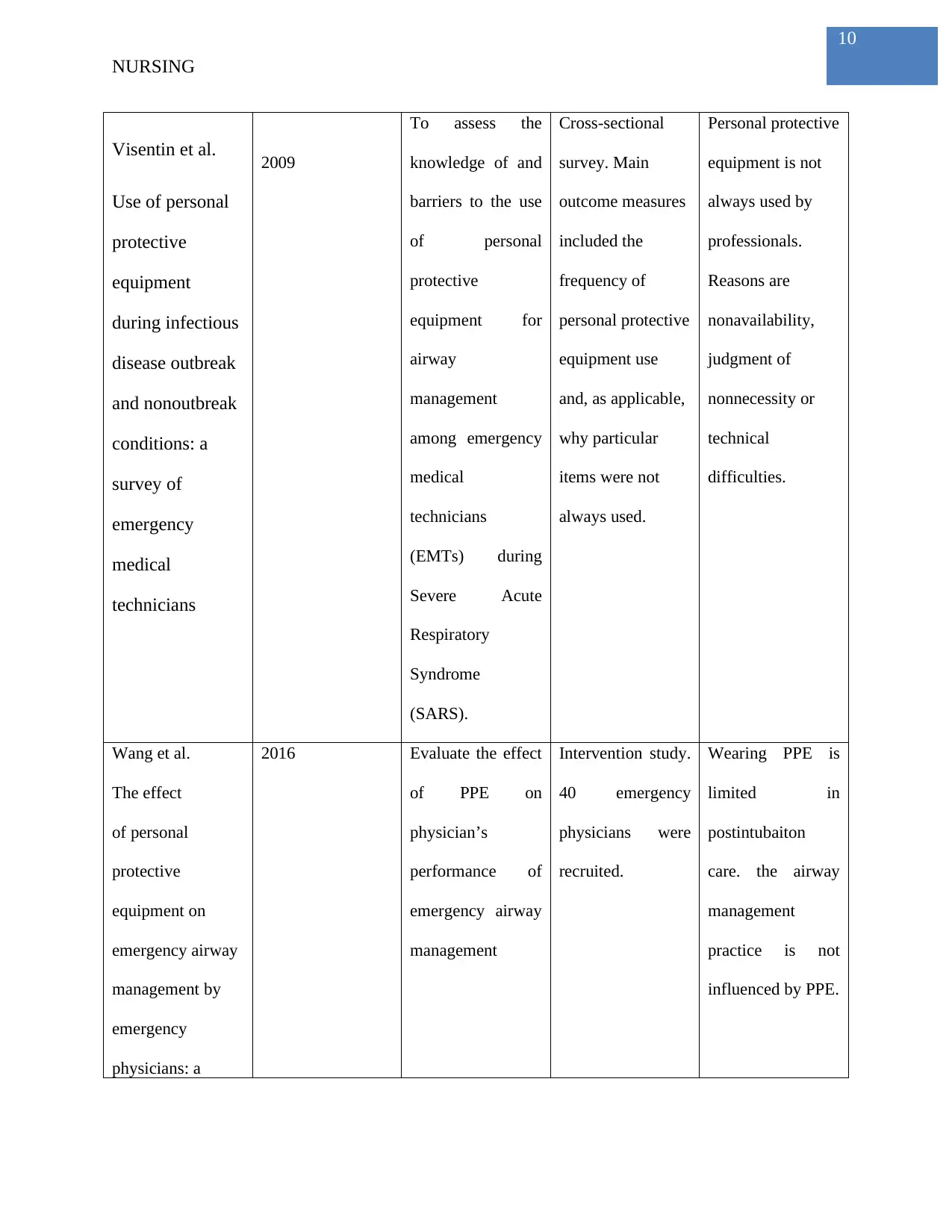
10
NURSING
Visentin et al.
Use of personal
protective
equipment
during infectious
disease outbreak
and nonoutbreak
conditions: a
survey of
emergency
medical
technicians
2009
To assess the
knowledge of and
barriers to the use
of personal
protective
equipment for
airway
management
among emergency
medical
technicians
(EMTs) during
Severe Acute
Respiratory
Syndrome
(SARS).
Cross-sectional
survey. Main
outcome measures
included the
frequency of
personal protective
equipment use
and, as applicable,
why particular
items were not
always used.
Personal protective
equipment is not
always used by
professionals.
Reasons are
nonavailability,
judgment of
nonnecessity or
technical
difficulties.
Wang et al.
The effect
of personal
protective
equipment on
emergency airway
management by
emergency
physicians: a
2016 Evaluate the effect
of PPE on
physician’s
performance of
emergency airway
management
Intervention study.
40 emergency
physicians were
recruited.
Wearing PPE is
limited in
postintubaiton
care. the airway
management
practice is not
influenced by PPE.
NURSING
Visentin et al.
Use of personal
protective
equipment
during infectious
disease outbreak
and nonoutbreak
conditions: a
survey of
emergency
medical
technicians
2009
To assess the
knowledge of and
barriers to the use
of personal
protective
equipment for
airway
management
among emergency
medical
technicians
(EMTs) during
Severe Acute
Respiratory
Syndrome
(SARS).
Cross-sectional
survey. Main
outcome measures
included the
frequency of
personal protective
equipment use
and, as applicable,
why particular
items were not
always used.
Personal protective
equipment is not
always used by
professionals.
Reasons are
nonavailability,
judgment of
nonnecessity or
technical
difficulties.
Wang et al.
The effect
of personal
protective
equipment on
emergency airway
management by
emergency
physicians: a
2016 Evaluate the effect
of PPE on
physician’s
performance of
emergency airway
management
Intervention study.
40 emergency
physicians were
recruited.
Wearing PPE is
limited in
postintubaiton
care. the airway
management
practice is not
influenced by PPE.

11
NURSING
mannequin study
Lu et al.
Viral load and
outcome in SARS
infection: The role
of personal
protective
equipment in the
emergency
department
2006 Evaluate the
effectiveness of
PPE against
infection in
emergency
department
Case study. 16
patients in a SARS
clister were
studied.
Although absolute
protection against
SARs was not
achieved, lower
exposure to virus
was noted that
leads to lower risk
of secondary
infection.
Kim et al.
Influence of
personal protective
equipment on the
performance of
life-saving
interventions by
emergency
medical service
personnel
2016 To assess the
efficacy of a
randomized
crossover
stimulation for
comparing
performance of
life-saving
interventions in
repetitive
simulation of
single-rescuer
resuscitation
wearing level-C
Success rate and
completion time of
intravenous
cannulation and
endotracheal
intubation was
compared
Performance level
of life-saving
interventions were
decreased when
PPE was used.
NURSING
mannequin study
Lu et al.
Viral load and
outcome in SARS
infection: The role
of personal
protective
equipment in the
emergency
department
2006 Evaluate the
effectiveness of
PPE against
infection in
emergency
department
Case study. 16
patients in a SARS
clister were
studied.
Although absolute
protection against
SARs was not
achieved, lower
exposure to virus
was noted that
leads to lower risk
of secondary
infection.
Kim et al.
Influence of
personal protective
equipment on the
performance of
life-saving
interventions by
emergency
medical service
personnel
2016 To assess the
efficacy of a
randomized
crossover
stimulation for
comparing
performance of
life-saving
interventions in
repetitive
simulation of
single-rescuer
resuscitation
wearing level-C
Success rate and
completion time of
intravenous
cannulation and
endotracheal
intubation was
compared
Performance level
of life-saving
interventions were
decreased when
PPE was used.
⊘ This is a preview!⊘
Do you want full access?
Subscribe today to unlock all pages.

Trusted by 1+ million students worldwide
1 out of 21
Related Documents
Your All-in-One AI-Powered Toolkit for Academic Success.
+13062052269
info@desklib.com
Available 24*7 on WhatsApp / Email
![[object Object]](/_next/static/media/star-bottom.7253800d.svg)
Unlock your academic potential
Copyright © 2020–2025 A2Z Services. All Rights Reserved. Developed and managed by ZUCOL.




